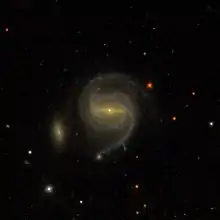| NGC 5000 | |
|---|---|
 | |
| Observation data (J2000 epoch) | |
| Constellation | Coma Berenices |
| Right ascension | 13h 09m 47s[1] |
| Declination | 28° 54′ 23″[1] |
| Redshift | 0.0187[1] |
| Distance | 258 Mly[1] |
| Characteristics | |
| Type | SBbc[1] |
| Apparent size (V) | 1.7′ × 1.4′[1] |
| Other designations | |
| CGCG 160-152, IRAS 13073+2910, MCG 5-31-144, PGC 45658, UGC 8241, V V 460. | |
NGC 5000 is a barred spiral galaxy in the constellation Coma Berenices.[1] It was discovered by William Herschel in 1785. It is also known as LEDA 45658, MCG+05-31-144, UGC 8241, VV 460, III 366, h 1544, and GC 3433.
Herschel discovered it with the help of 18.7-inch f/13 speculum telescope.[2] It is very faint, very small and irregularly round with weak concentration.[3]
One supernova has been observed in NGC 5000: SN 2003el (type Ic, mag. 18.8).[4]
References
- 1 2 3 4 5 6 7 Rojas, Sebastián García. "Galaxy NGC 5000 - Galaxy in Coma Berenices Constellation". Telescopius. Retrieved 2022-10-28.
- ↑ "DOCdb - NGC 5000". www.docdb.net. Retrieved 2022-10-28.
- ↑ "NGC 5000 - NGC/IC Project". Archived from the original on 2013-01-15. Retrieved 2017-01-05.
- ↑ Transient Name Server entry for SN 2003el. Retrieved 3 April 2023.
External links
 Media related to NGC 5000 at Wikimedia Commons
Media related to NGC 5000 at Wikimedia Commons
This article is issued from Wikipedia. The text is licensed under Creative Commons - Attribution - Sharealike. Additional terms may apply for the media files.